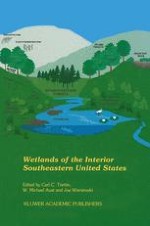1995 | OriginalPaper | Chapter
Hillslope Nutrient Flux During Near-Stream Vegetation Removal I. A Multi-Scaled Modeling Design
Authors : J. A. Yeakley, J. L. Meyer, W. T. Swank
Published in: Wetlands of the Interior Southeastern United States
Publisher: Springer Netherlands
Included in: Professional Book Archive
Activate our intelligent search to find suitable subject content or patents.
Select sections of text to find matching patents with Artificial Intelligence. powered by
Select sections of text to find additional relevant content using AI-assisted search. powered by
At the Coweeta Hydrologic Laboratory in the southern Appalachians of western North Carolina, a near-stream vegetation manipulation experiment is being conducted to determine the effect of removal of streamside Rhododendron maximum L. on the export of hillslope nutrients (K, Na, Ca, Mg, N, P, S) and organic matter. Experimental hillslope transects that span topographical flowpaths from a local highpoint to the stream have been instrumented with lysimeters and TDR rods at two depths, as well as with streambed and streambank piezometers. We present a review of studies of nutrient flux in the riparian zone of forested watersheds. In the southern Appalachians, we hypothesize that R. maximum is a keystone species at the interface between terrestrial and aquatic systems, with extensive near-stream thickets having a possible impact on carbon and nutrient transport into streams. We present the conceptual basis and initial implementation of a model-based experimental design to test the effect of R. maximum removal on hillslope nutrient and organic matter export in upland watersheds. The model is terrain-based and will be used to extrapolate elemental flux measurements both spatially from the hillslope to watershed scale and temporally for various climate regimes. The model consists of three modules: (1) objective terrain analysis (TAPES-C); (2) a dynamic interception canopy module; (3) a hillslope hydrology module (IHDM4) with a 2-D Richard’s equation of subsurface moisture dynamics. Calibration and validation of the model will occur at two scales: at the hillslope scale, using well, lysimeter, and TDR data; at the watershed scale, using streamflow measurements across a variety of storm types. We show watershed terrain analysis for the experimental watershed (WS56) and discuss use of the model for understanding effects of watershed management of riparian zone processes.
